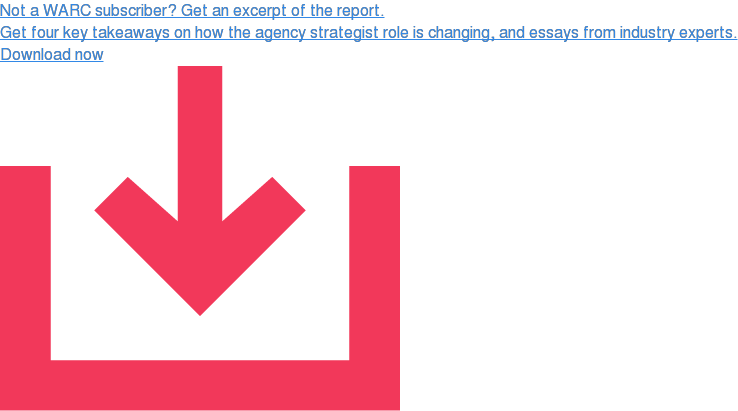This commentary appears in WARC’s new ‘Future of Strategy’ report, based on a global survey of senior agency planners. The report covers the current state of the strategic discipline, future opportunities and challenges, and guidance on building the planning team of the future.
More than ever, agencies are expected to break new ground, and break records doing it; working with less money and time than ever before. And so we find ourselves in a bind. Follow agency process or see how far we can get stripped of linear protocol. To solve problems formulaically, or naked?
Process doesn’t always lead to progress. Planning ‘flow’, like creative flow, is achieved through following a set of principles or beliefs about the industry we’re in. We’re in the industry of understanding people and using that to make brands more interesting. We’re in the industry of connecting our clients to exactly what matters to the people that really matter to them; finding a common ground to occupy, and engineering a value exchange that works for everyone.
Process can be great when you already know what the solution needs to look like. But what about when the brief is open?
A feeling of freedom is essential when solving the sort of wicked problems that our clients often bear. I borrow the word ‘wicked’ from systems thinking, which has a lot to offer the world of planning, to describe the problems that leave us unsure where to start and can never be solved with a single, simple solution.
Freedom, in my experience, is best driven by two things: healthy scepticism and restless curiosity. Two voices in my head that bring discomfort and insight in equal measure, and one of the defining and enduring characteristics of the Naked brand that I fell in love with almost 10 years ago.
Process has a place, of course, but the magic happens when you free it up and allow your beliefs to shape it or break it at any given time. Everything communicates; See the bigger picture; All media is earned media; Challenge convention; Strategic creativity. Some of these beliefs are written on our walls, some aren’t, but here are a couple of ways in which they are freeing up planning process at Naked in Australia.
Changing the brief
Clients are increasingly bringing briefs to the table where they aren’t stipulating the answers. And open briefs thrive in open process.
So in these circumstances we often break off the bottom half of the creative brief, and stop short of giving the creative teams a reductionist proposition. Instead, we’ve invested in training our creative outfit in behavioural science, and created a behaviour change toolkit for ideation. Arriving at the creative brief, therefore, becomes a strategic exercise of translating the client’s challenge into a behavioural objective – turning a marketing problem into a people problem – and working collaboratively from there.
This also means that our creatives come to the table sooner and get their hands dirty with the strategy.
Design thinking
The design world continues to influence the way we approach solving problems and identifying opportunities with our clients. Take, for example, the “Double Diamond” model.
It places equal emphasis on the searching and selecting of problems and solutions. Whilst we set our stalls out as professional problem solvers, we can be guilty of selecting solutions based on unproven assumptions and ‘gut feel’. But, using this process, we ensure we set aside time and money for executing low-cost experiments to validate our assumptions and put some well-placed strategic rigour behind our chosen solutions. I’ve found another great tool for this approach has been the Validation Board from Lean Start-up Machine.
At Naked we’ve been experimenting with these models and have found them to be tremendously effective. Not only have they helped to free up our strategic processes, but it’s allowed us to go to clients having validated both their problem and our proposed solution.
Design thinking is immensely powerful, and a concept that’s increasingly welcome in C-suites; much more so than the idea of advertising.
The marketing industry has taken on a lot of the rhetoric from the tech world about “failing fast”. Whilst the sentiment is spot on, the emphasis is wrong. No client wants to buy failure. The emphasis should be on the product of fast failure, which is learning quickly. What if we viewed planning and strategy in less absolute terms, and more as an ongoing experiment? What if we openly acknowledged not only what we do know, but also what we don’t and cannot know? And what if we called out our assumptions, rather than disguised them, and designed experiments to validate them?
The more uncertain things get, the more certain I am that freedom in the planning function is essential. Freedom to use your scepticism and curiosity to develop zero-based strategy; starting with nothing but your belief in what great work looks like and a contemporary planning toolkit to build with.



